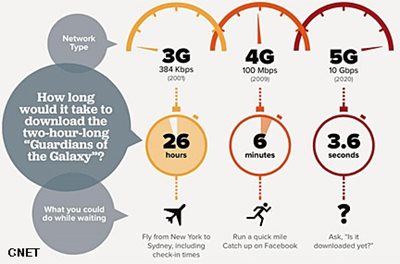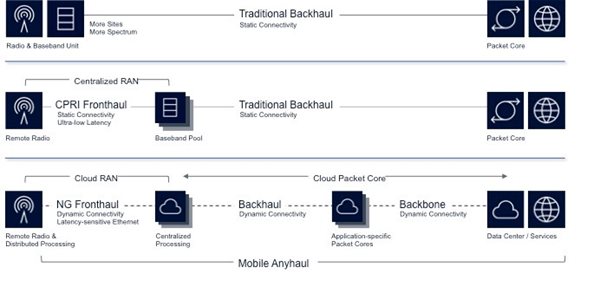By Lisa Huff, Discerning Analytics
The wireless infrastructure market is evolving. While mobile operators must maintain their 2G and 3G networks, they are also busy upgrading as much of them as they can to LTE and LTE-A now and planning for 5G in the next few years. As a result, we are now starting to see entirely new types of equipment. This article highlights content to be presented in Market Watch Panel 2 where industry experts discuss these and other optical technologies that are poised to enable the deployment of 5G.
5G mobile network technologies offer the potential of 30 to 50 times faster speeds than 4G. An example of this is shown in the below diagram.

Figure 1: Comparison of Mobile Radio Technologies (Source: CNET)
The performance improvements offered by 5G are considered a key element in the expansion of the Internet of Things. Entirely new applications including virtual/augmented reality and autonomous vehicle management will require the speed and reliability promised by 5G.
The 5G-radio network and mobile infrastructure advancements are needed to support the ever-increasing requirement for more mobile bandwidth. In 2015, AT&T noted, “Over the last seven years we’ve had over 50,000% growth just in the wireless data traffic across our network.” Based on modeling from several sources, including Cisco, GSMA and Nokia Bell Labs, mobile broadband traffic will continue this trend with a doubling yearly overall and an increase of up to 20 times in some urban areas in 2018. Over two-thirds of the traffic will come from video.
Ericsson, Huawei, Nokia and ZTE are all shipping pre-standard 5G technologies for evaluation, testing and field trials. However, 5G upgrades cannot become a reality without also improving existing mobile infrastructure equipment. Air-interfaces and radio access network (RAN) systems need to be completely redesigned to accommodate 5G. They will need massive capacity, billions of connections and ultra-fast network speeds. This is where the 5G New Radio (NR) and massive multiple-in-multiple-out (MIMO) technology is being leveraged. Massive MIMO is the technology that enables distributed antenna systems (DAS), which will become increasingly important, as we get closer to 5G deployments.
While the core wireless network is progressing, the backhaul will also be evolving to include more and more Carrier Ethernet of all forms – fiber, copper and microwave, however, it will remain mostly microwave in the near term. Yet, as 5G devices become available in late 2018 or the beginning of 2019, the network will transition again as shown in the diagram below.

Figure 2: Mobile "Anyhaul" (Source: Ericsson)
For many years, mobile network operators (MNOs) have been looking for ways to support this ever burgeoning growth of data traffic and at the same time cut both capital expenditures (CAPEX) as well as operational expenditures (OPEX). In 2010, China Mobile Research Institute proposed a way to save both by centralizing baseband processing so it can serve more than one radio head. This has come to be known as centralized (then eventually cloud) RAN (radio access network) or C-RAN. In legacy networks, the baseband-processing unit (BBU) has always been located on-site near the bottom of the cellular antenna. This forced MNOs to lease the space, run power to every BBU and cool the equipment inside, thus keeping OPEX costs high. C-RAN changes the architecture to centralize multiple BBUs in a single location, either at a cell site or at a centralized BBU pool location, which allows simplification of equipment needed at each individual cell site. The above diagram shows the evolution of this portion of the network.
The new longer connection from the Remote Radio Head (RRH) to the centralized BBU is known as the Fronthaul. This connection from the BBU to the radios changes from a coax connection from the bottom of the base station to a fiber connection in the fronthaul. There are two technologies that are being used for this new Fronthaul connection Common Public Radio Interface (CPRI) and Open Base Station Architecture Initiative (OBSAI).
Mobile backhaul has, for years, been dominated by microwave connections. With the advent of LTE-A and in anticipation of 5G, this is slowly changing to Carrier Ethernet and various versions of next generation passive optical networking (PON). Each backhaul network may have a different technology depending on what it is connecting. From a macrocell to the core, the technology is typically microwave or fiber using Ethernet or DWDM. From an enterprise to the core, it is typically fiber using Ethernet or DWDM. The Ethernet can be true Carrier Ethernet or native Ethernet running over some form of PON.
This part of the network is sometimes owned by the MNO, but many times the MNO leases fiber from other network operators – either other carriers, fiber network operators like Level 3 (now CenturyLink), Telia Carrier or Zayo, or multi-service operators (MSOs) like Comcast. Many different connection technologies are still being used in the mobile backhaul network including fiber, high-speed copper Ethernet and RF. However, we see this changing quickly in the next five years to mostly fiber to enable the lower latency and higher data rates the applications need.
Posted: 1 March 2018 by
Lisa Huff, Discerning Analytics
| with 0 comments